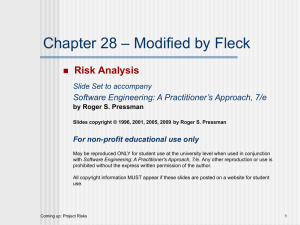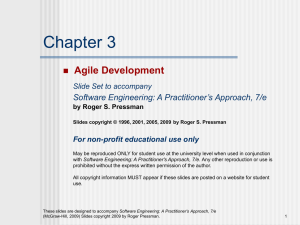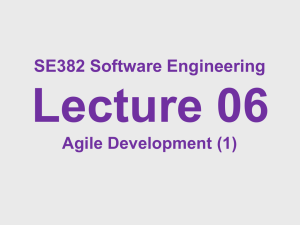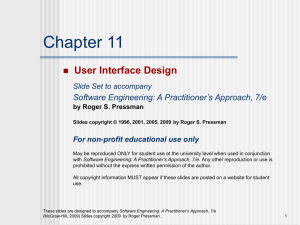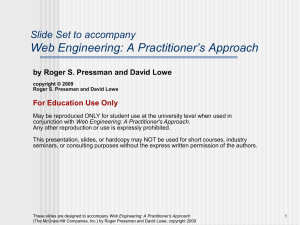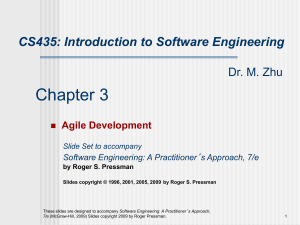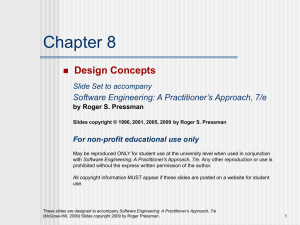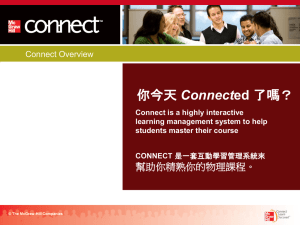Requirements Modelling: Scenarios, Information and Analysis Classes
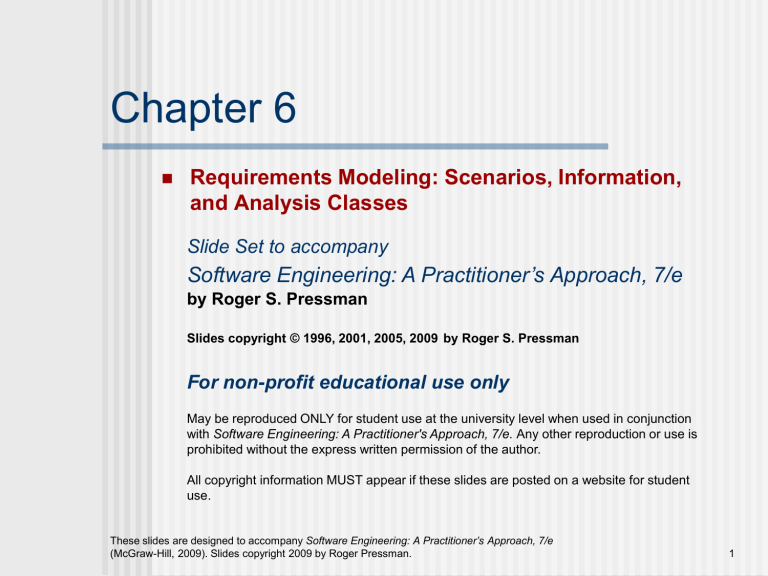
Chapter 6
Requirements Modeling: Scenarios, Information, and Analysis Classes
Slide Set to accompany
Software Engineering: A Practitioner’s Approach, 7/e by Roger S. Pressman
Slides copyright © 1996, 2001, 2005, 2009 by Roger S. Pressman
For non-profit educational use only
May be reproduced ONLY for student use at the university level when used in conjunction with Software Engineering: A Practitioner's Approach, 7/e. Any other reproduction or use is prohibited without the express written permission of the author.
All copyright information MUST appear if these slides are posted on a website for student use.
These slides are designed to accompany Software Engineering: A Practitioner’s Approach, 7/e
(McGraw-Hill, 2009). Slides copyright 2009 by Roger Pressman.
1
Requirements Analysis
Requirements analysis
specifies software’s operational characteristics
indicates software's interface with other system elements establishes constraints that software must meet
Requirements analysis allows the software engineer
(called an analyst or modeler in this role) to:
elaborate on basic requirements established during earlier requirement engineering tasks build models that depict user scenarios, functional activities, problem classes and their relationships, system and class behavior, and the flow of data as it is transformed.
These slides are designed to accompany Software Engineering: A Practitioner’s Approach, 7/e
(McGraw-Hill, 2009). Slides copyright 2009 by Roger Pressman.
2
A Bridge
system description analysis model design model
These slides are designed to accompany Software Engineering: A Practitioner’s Approach, 7/e
(McGraw-Hill, 2009). Slides copyright 2009 by Roger Pressman.
3
Rules of Thumb
The model should focus on requirements that are visible within the problem or business domain. The level of abstraction should be relatively high.
Each element of the analysis model should add to an overall understanding of software requirements and provide insight into the information domain, function and behavior of the system.
Delay consideration of infrastructure and other nonfunctional models until design.
Minimize coupling throughout the system.
Be certain that the analysis model provides value to all stakeholders.
Keep the model as simple as it can be.
These slides are designed to accompany Software Engineering: A Practitioner’s Approach, 7/e
(McGraw-Hill, 2009). Slides copyright 2009 by Roger Pressman.
4
Domain Analysis
Software domain analysis is the identification, analysis, and specification of common requirements from a specific application domain, typically for reuse on multiple projects within that application domain . . .
[Object-oriented domain analysis is] the identification, analysis, and specification of common, reusable capabilities within a specific application domain, in terms of common objects, classes, subassemblies, and frameworks . . .
Donald Firesmith
These slides are designed to accompany Software Engineering: A Practitioner’s Approach, 7/e
(McGraw-Hill, 2009). Slides copyright 2009 by Roger Pressman.
5
Domain Analysis
Define the domain to be investigated.
Collect a representative sample of applications in the domain.
Analyze each application in the sample.
Develop an analysis model for the objects.
These slides are designed to accompany Software Engineering: A Practitioner’s Approach, 7/e
(McGraw-Hill, 2009). Slides copyright 2009 by Roger Pressman.
6
Elements of Requirements Analysis
These slides are designed to accompany Software Engineering: A Practitioner’s Approach, 7/e
(McGraw-Hill, 2009). Slides copyright 2009 by Roger Pressman.
7
Scenario-Based Modeling
“[Use-cases] are simply an aid to defining what exists outside the system (actors) and what should be performed by the system (usecases).” Ivar Jacobson
(1) What should we write about?
(2) How much should we write about it?
(3) How detailed should we make our description?
(4) How should we organize the description?
These slides are designed to accompany Software Engineering: A Practitioner’s Approach, 7/e
(McGraw-Hill, 2009). Slides copyright 2009 by Roger Pressman.
8
What to Write About?
Inception and elicitation —provide you with the information you’ll need to begin writing use cases.
Requirements gathering meetings, QFD, and other requirements engineering mechanisms are used to
identify stakeholders define the scope of the problem specify overall operational goals establish priorities outline all known functional requirements, and
describe the things (objects) that will be manipulated by the system.
To begin developing a set of use cases, list the functions or activities performed by a specific actor .
These slides are designed to accompany Software Engineering: A Practitioner’s Approach, 7/e
(McGraw-Hill, 2009). Slides copyright 2009 by Roger Pressman.
9
How Much to Write About?
As further conversations with the stakeholders progress, the requirements gathering team develops use cases for each of the functions noted.
In general, use cases are written first in an informal narrative fashion.
If more formality is required, the same use case is rewritten using a structured format similar to the one proposed.
These slides are designed to accompany Software Engineering: A Practitioner’s Approach, 7/e
(McGraw-Hill, 2009). Slides copyright 2009 by Roger Pressman.
10
Use-Cases
a scenario that describes a “thread of usage” for a system actors represent roles people or devices play as the system functions users can play a number of different roles for a given scenario
These slides are designed to accompany Software Engineering: A Practitioner’s Approach, 7/e
(McGraw-Hill, 2009). Slides copyright 2009 by Roger Pressman.
11
Developing a Use-Case
What are the main tasks or functions that are performed by the actor?
What system information will the the actor acquire, produce or change?
Will the actor have to inform the system about changes in the external environment?
What information does the actor desire from the system?
Does the actor wish to be informed about unexpected changes?
These slides are designed to accompany Software Engineering: A Practitioner’s Approach, 7/e
(McGraw-Hill, 2009). Slides copyright 2009 by Roger Pressman.
12
Use-Case Diagram
Saf eHome
Access camera surveillance via t he
Int ernet
Conf igure Saf eHome syst em paramet ers cameras homeowner
Set alarm
These slides are designed to accompany Software Engineering: A Practitioner’s Approach, 7/e
(McGraw-Hill, 2009). Slides copyright 2009 by Roger Pressman.
13
Activity Diagram
Supplements the use case by providing a graphical representation of the flow of interaction within a specific scenario ent er password and user ID valid passwor ds/ ID invalid passwor ds/ ID select major f unct ion ot her f unct ions m ay also be select ed selec t surveillance prompt f or reent ry no input t r ies r em ain input t r ies r em ain t hum bnail views select a specif ic cam er a select specif ic camera - t humbnails select camera icon view camera out put in labelled window prompt f or anot her v iew exit t his f unct ion see anot her cam er a
These slides are designed to accompany Software Engineering: A Practitioner’s Approach, 7/e
(McGraw-Hill, 2009). Slides copyright 2009 by Roger Pressman.
14
Swimlane Diagrams
h o m e o w n e r
Allows the modeler to represent the flow of activities described by the use-case and at the same time indicate which actor (if there are multiple actors involved in a specific use-case) or analysis class has responsibility for the action described by an activity rectangle ent er pas sword and us er ID s elec t m ajor f unc t ion o t h er f u n ct io n s m ay also b e select ed select s urveillanc e t h u m b n ail views select a sp ecif ic cam er a s elec t s pecif ic c am era - t hum bnails selec t cam era icon c a m e r a valid p asswo r d s/ ID i n t e r f a c e in valid p asswo r d s/ ID prom pt f or reent ry in p u t t r ies r em ain n o in p u t t r ies r em ain generat e video out put view c am era out put in labelled window prom pt f or anot her view exit t h is f u n ct io n see an o t h er cam er a
These slides are designed to accompany Software Engineering: A Practitioner’s Approach, 7/e
(McGraw-Hill, 2009). Slides copyright 2009 by Roger Pressman.
15
Data Modeling
examines data objects independently of processing focuses attention on the data domain creates a model at the customer’s level of abstraction indicates how data objects relate to one another
These slides are designed to accompany Software Engineering: A Practitioner’s Approach, 7/e
(McGraw-Hill, 2009). Slides copyright 2009 by Roger Pressman.
16
What is a Data Object?
a representation of almost any composite information that must be understood by software.
composite information — something that has a number of different properties or attributes can be an external entity (e.g., anything that produces or consumes information), a thing (e.g., a report or a display), an occurrence (e.g., a telephone call) or event
(e.g., an alarm), a role (e.g., salesperson), an organizational unit (e.g., accounting department), a place
(e.g., a warehouse), or a structure (e.g., a file).
The description of the data object incorporates the data object and all of its attributes.
A data object encapsulates data only —there is no reference within a data object to operations that act on the data.
These slides are designed to accompany Software Engineering: A Practitioner’s Approach, 7/e
(McGraw-Hill, 2009). Slides copyright 2009 by Roger Pressman.
17
Data Objects and Attributes
A data object contains a set of attributes that act as an aspect, quality, characteristic, or descriptor of the object object: automobile attributes: make model body type price options code
These slides are designed to accompany Software Engineering: A Practitioner’s Approach, 7/e
(McGraw-Hill, 2009). Slides copyright 2009 by Roger Pressman.
18
What is a Relationship?
Data objects are connected to one another in different ways.
A connection is established between person and car because the two objects are related.
• A person owns a car
• A person is insured to drive a car
The relationships owns and insured to drive define the relevant connections between person and car .
Several instances of a relationship can exist
Objects can be related in many different ways
These slides are designed to accompany Software Engineering: A Practitioner’s Approach, 7/e
(McGraw-Hill, 2009). Slides copyright 2009 by Roger Pressman.
19
ERD Notation
One common form: object
1
(0, m) relationship
(1, 1) object
2 attribute
Another common form: object
1
(0, m) relationship
(1, 1) object
2
These slides are designed to accompany Software Engineering: A Practitioner’s Approach, 7/e
(McGraw-Hill, 2009). Slides copyright 2009 by Roger Pressman.
20
Building an ERD
Level 1 —model all data objects (entities) and their “connections” to one another
Level 2 —model all entities and relationships
Level 3 —model all entities, relationships, and the attributes that provide further depth
These slides are designed to accompany Software Engineering: A Practitioner’s Approach, 7/e
(McGraw-Hill, 2009). Slides copyright 2009 by Roger Pressman.
21
The ERD: An Example
Customer
(1,1) standard task table
(1,1) selected from
(1,w) work tasks places
(1,m) request for service
(1,1) generates
(1,n) work order
(1,1)
(1,1)
(1,w) consists of materials
(1,i) lists
These slides are designed to accompany Software Engineering: A Practitioner’s Approach, 7/e
(McGraw-Hill, 2009). Slides copyright 2009 by Roger Pressman.
22
Class-Based Modeling
Class-based modeling represents:
objects that the system will manipulate
operations (also called methods or services) that will be applied to the objects to effect the manipulation relationships (some hierarchical) between the objects collaborations that occur between the classes that are defined.
The elements of a class-based model include classes and objects, attributes, operations,
CRC models, collaboration diagrams and packages.
These slides are designed to accompany Software Engineering: A Practitioner’s Approach, 7/e
(McGraw-Hill, 2009). Slides copyright 2009 by Roger Pressman.
23
Identifying Analysis Classes
Examining the usage scenarios developed as part of the requirements model and perform a
"grammatical parse" [Abb83]
Classes are determined by underlining each noun or noun phrase and entering it into a simple table.
Synonyms should be noted.
If the class (noun) is required to implement a solution, then it is part of the solution space; otherwise, if a class is necessary only to describe a solution, it is part of the problem space.
But what should we look for once all of the nouns have been isolated?
These slides are designed to accompany Software Engineering: A Practitioner’s Approach, 7/e
(McGraw-Hill, 2009). Slides copyright 2009 by Roger Pressman.
24
Manifestations of Analysis Classes
Analysis classes manifest themselves in one of the following ways:
•
External entities (e.g., other systems, devices, people) that produce or consume information
• Things (e.g, reports, displays, letters, signals) that are part of the information domain for the problem
• Occurrences or events (e.g., a property transfer or the completion of a series of robot movements) that occur within the context of system operation
•
Roles (e.g., manager, engineer, salesperson) played by people who interact with the system
• Organizational units (e.g., division, group, team) that are relevant to an application
•
Places (e.g., manufacturing floor or loading dock) that establish the context of the problem and the overall function
• Structures (e.g., sensors, four-wheeled vehicles, or computers) that define a class of objects or related classes of objects
These slides are designed to accompany Software Engineering: A Practitioner’s Approach, 7/e
(McGraw-Hill, 2009). Slides copyright 2009 by Roger Pressman.
25
Potential Classes
Retained information.
The potential class will be useful during analysis only if information about it must be remembered so that the system can function.
Needed services.
The potential class must have a set of identifiable operations that can change the value of its attributes in some way.
Multiple attributes.
During requirement analysis, the focus should be on
"major" information; a class with a single attribute may, in fact, be useful during design, but is probably better represented as an attribute of another class during the analysis activity.
Common attributes.
A set of attributes can be defined for the potential class and these attributes apply to all instances of the class.
Common operations.
A set of operations can be defined for the potential class and these operations apply to all instances of the class.
Essential requirements.
External entities that appear in the problem space and produce or consume information essential to the operation of any solution for the system will almost always be defined as classes in the requirements model.
These slides are designed to accompany Software Engineering: A Practitioner’s Approach, 7/e
(McGraw-Hill, 2009). Slides copyright 2009 by Roger Pressman.
26
Defining Attributes
Attributes describe a class that has been selected for inclusion in the analysis model.
build two different classes for professional baseball players
• For Playing Statistics software: name, position, batting average, fielding percentage, years played, and games played might be relevant
• For Pension Fund software: average salary, credit toward full vesting, pension plan options chosen, mailing address, and the like.
These slides are designed to accompany Software Engineering: A Practitioner’s Approach, 7/e
(McGraw-Hill, 2009). Slides copyright 2009 by Roger Pressman.
27
Defining Operations
Do a grammatical parse of a processing narrative and look at the verbs
Operations can be divided into four broad categories:
(1) operations that manipulate data in some way
(e.g., adding, deleting, reformatting, selecting)
(2) operations that perform a computation
(3) operations that inquire about the state of an object, and
(4) operations that monitor an object for the occurrence of a controlling event.
These slides are designed to accompany Software Engineering: A Practitioner’s Approach, 7/e
(McGraw-Hill, 2009). Slides copyright 2009 by Roger Pressman.
28
CRC Models
Class-responsibility-collaborator (CRC) modeling [Wir90] provides a simple means for identifying and organizing the classes that are relevant to system or product requirements.
Ambler [Amb95] describes CRC modeling in the following way:
A CRC model is really a collection of standard index cards that represent classes. The cards are divided into three sections. Along the top of the card you write the name of the class. In the body of the card you list the class responsibilities on the left and the collaborators on the right.
These slides are designed to accompany Software Engineering: A Practitioner’s Approach, 7/e
(McGraw-Hill, 2009). Slides copyright 2009 by Roger Pressman.
29
CRC Modeling
Class:
Class:
Class:
Description: Class: FloorPlan
Description:
Responsibility:
Responsibility:
Responsibility:
Responsibility: defines floor plan name/type manages floor plan positioning
Collaborator:
Collaborator: scales floor plan for display scales floor plan for display incorporates walls, doors and windows shows position of video cameras
Collaborator:
Collaborator:
Wall
Camera
These slides are designed to accompany Software Engineering: A Practitioner’s Approach, 7/e
(McGraw-Hill, 2009). Slides copyright 2009 by Roger Pressman.
30
Class Types
Entity classes , also called model or business classes , are extracted directly from the statement of the problem (e.g.,
FloorPlan and Sensor).
Boundary classes are used to create the interface (e.g., interactive screen or printed reports) that the user sees and interacts with as the software is used.
Controller classes manage a “unit of work” [UML03] from start to finish. That is, controller classes can be designed to manage
the creation or update of entity objects; the instantiation of boundary objects as they obtain information from entity objects; complex communication between sets of objects; validation of data communicated between objects or between the user and the application.
These slides are designed to accompany Software Engineering: A Practitioner’s Approach, 7/e
(McGraw-Hill, 2009). Slides copyright 2009 by Roger Pressman.
31
Responsibilities
System intelligence should be distributed across classes to best address the needs of the problem
Each responsibility should be stated as generally as possible
Information and the behavior related to it should reside within the same class
Information about one thing should be localized with a single class, not distributed across multiple classes.
Responsibilities should be shared among related classes, when appropriate.
These slides are designed to accompany Software Engineering: A Practitioner’s Approach, 7/e
(McGraw-Hill, 2009). Slides copyright 2009 by Roger Pressman.
32
Collaborations
Classes fulfill their responsibilities in one of two ways:
A class can use its own operations to manipulate its own attributes, thereby fulfilling a particular responsibility, or a class can collaborate with other classes.
Collaborations identify relationships between classes
Collaborations are identified by determining whether a class can fulfill each responsibility itself three different generic relationships between classes [WIR90]:
the is-part-of relationship the has-knowledge-of relationship the depends-upon relationship
These slides are designed to accompany Software Engineering: A Practitioner’s Approach, 7/e
(McGraw-Hill, 2009). Slides copyright 2009 by Roger Pressman.
33
Composite Aggregate Class
Player
PlayerHead PlayerBody PlayerArms PlayerLegs
These slides are designed to accompany Software Engineering: A Practitioner’s Approach, 7/e
(McGraw-Hill, 2009). Slides copyright 2009 by Roger Pressman.
34
Associations and Dependencies
Two analysis classes are often related to one another in some fashion
In UML these relationships are called associations
Associations can be refined by indicating multiplicity
(the term cardinality is used in data modeling
In many instances, a client-server relationship exists between two analysis classes.
In such cases, a client-class depends on the serverclass in some way and a dependency relationship is established
These slides are designed to accompany Software Engineering: A Practitioner’s Approach, 7/e
(McGraw-Hill, 2009). Slides copyright 2009 by Roger Pressman.
35
Multiplicity
Wall
1 1 1
1..* is used to build
WallSegm ent Window is used to build
0..* is used to build
0..*
Door
These slides are designed to accompany Software Engineering: A Practitioner’s Approach, 7/e
(McGraw-Hill, 2009). Slides copyright 2009 by Roger Pressman.
36
Dependencies
DisplayWindow
<<access>>
{password}
Camera
These slides are designed to accompany Software Engineering: A Practitioner’s Approach, 7/e
(McGraw-Hill, 2009). Slides copyright 2009 by Roger Pressman.
37
Analysis Packages
Various elements of the analysis model (e.g., use-cases, analysis classes) are categorized in a manner that packages them as a grouping
The plus sign preceding the analysis class name in each package indicates that the classes have public visibility and are therefore accessible from other packages.
Other symbols can precede an element within a package. A minus sign indicates that an element is hidden from all other packages and a # symbol indicates that an element is accessible only to packages contained within a given package.
These slides are designed to accompany Software Engineering: A Practitioner’s Approach, 7/e
(McGraw-Hill, 2009). Slides copyright 2009 by Roger Pressman.
38
Analysis Packages
package name
Environment
+Tree
+Landscape
+Road
+Wall
+Bridge
+Building
+VisualEffect
+Scene
RulesOf TheGame
+RulesOfMovement
+ConstraintsOnAction
Charact ers
+Player
+Protagonist
+Antagonist
+SupportingRole
These slides are designed to accompany Software Engineering: A Practitioner’s Approach, 7/e
(McGraw-Hill, 2009). Slides copyright 2009 by Roger Pressman.
39
Reviewing the CRC Model
All participants in the review (of the CRC model) are given a subset of the CRC model index cards.
Cards that collaborate should be separated (i.e., no reviewer should have two cards that collaborate).
All use-case scenarios (and corresponding use-case diagrams) should be organized into categories.
The review leader reads the use-case deliberately.
As the review leader comes to a named object, she passes a token to the person holding the corresponding class index card.
When the token is passed, the holder of the class card is asked to describe the responsibilities noted on the card.
The group determines whether one (or more) of the responsibilities satisfies the use-case requirement.
If the responsibilities and collaborations noted on the index cards cannot accommodate the use-case, modifications are made to the cards.
This may include the definition of new classes (and corresponding CRC index cards) or the specification of new or revised responsibilities or collaborations on existing cards.
These slides are designed to accompany Software Engineering: A Practitioner’s Approach, 7/e
(McGraw-Hill, 2009). Slides copyright 2009 by Roger Pressman.
40
